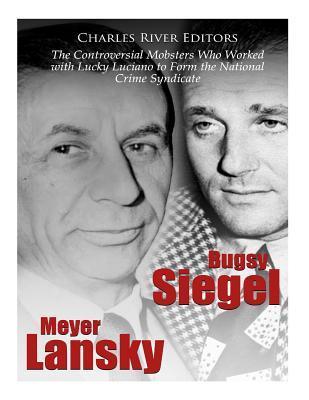Bugsy Siegel and Meyer Lansky: The Controversial Mobsters Who Worked with Lucky Luciano to Form the National Crime Syndicate

Bugsy Siegel and Meyer Lansky: The Controversial Mobsters Who Worked with Lucky Luciano to Form the National Crime Syndicate
*Includes online resources and a bibliography for further reading
In the last 70 years, a countless number of people have come across the grisly and morbidly fascinating crime scene photographs of Benjamin "Bugsy" Siegel's murder. The photographs are as disconcerting as they are iconic, for they show a gritty glimpse into the haunting reality of a life too often glamorized by pop culture. The less-publicized photograph of Bugsy in the morgue is, in a way, a more chilling reminder of the barbarity and callous irony behind the term "organized crime." With the blood on his face rinsed off and his hair slicked back, it almost seems as if the photographer had caught Bugsy mid-slumber, but the balls of cotton plugging the gaping bullet holes in his face suggest otherwise. One minute, the fearless Bugsy was stalking the streets of Sin City, his mere presence enough to make even the most hardened thugs break out in a cold sweat, and the next minute, Bugsy was reduced to an unrecognizable body sprawled out on a hard metal slab, with the name on his toe tag misspelled.
Bugsy, who helped turn Las Vegas into what it became, had risen to the upper echelons of New York's criminal underworld along with his childhood friend, Meyer Lansky. One of America's most infamous mobsters, Lansky was also one of the most mysterious, a perplexing, yet inexplicably intriguing individual with multiple reputations. To his admirers, he was in many ways the ultimate genius and survivor within the callous and cut-throat world of 20th century organized crime. Even in adulthood, Meyer was smaller than most, standing anywhere between 4'11" to 5'4", and weighing 136 pounds at his heaviest. He was not merely an intellectual - he was worldly and wise, one who often doled out advice akin to poetry to his children and grandchildren, his gravelly voice oddly soothing. At the same time, he had all the stealth and cunning of a sphinx, and while remarkably even-tempered, gangsters twice his size dared not cross him. To them, he was no more than a wildly ambitious, often misunderstood entrepreneur who trod upon the border between legality and lawlessness with all the mastery of a tightrope artist. He was, above all, the definition of humility, one whose "handshake was worth more than any contract," and a man who actively dodged the spotlight that doggedly tailed him until the end of his days.
Conversely, most will quickly concede that while Lansky was an exception
PRP: 111.14 Lei
Acesta este Prețul Recomandat de Producător. Prețul de vânzare al produsului este afișat mai jos.
100.03Lei
100.03Lei
111.14 LeiLivrare in 2-4 saptamani
Descrierea produsului
*Includes online resources and a bibliography for further reading
In the last 70 years, a countless number of people have come across the grisly and morbidly fascinating crime scene photographs of Benjamin "Bugsy" Siegel's murder. The photographs are as disconcerting as they are iconic, for they show a gritty glimpse into the haunting reality of a life too often glamorized by pop culture. The less-publicized photograph of Bugsy in the morgue is, in a way, a more chilling reminder of the barbarity and callous irony behind the term "organized crime." With the blood on his face rinsed off and his hair slicked back, it almost seems as if the photographer had caught Bugsy mid-slumber, but the balls of cotton plugging the gaping bullet holes in his face suggest otherwise. One minute, the fearless Bugsy was stalking the streets of Sin City, his mere presence enough to make even the most hardened thugs break out in a cold sweat, and the next minute, Bugsy was reduced to an unrecognizable body sprawled out on a hard metal slab, with the name on his toe tag misspelled.
Bugsy, who helped turn Las Vegas into what it became, had risen to the upper echelons of New York's criminal underworld along with his childhood friend, Meyer Lansky. One of America's most infamous mobsters, Lansky was also one of the most mysterious, a perplexing, yet inexplicably intriguing individual with multiple reputations. To his admirers, he was in many ways the ultimate genius and survivor within the callous and cut-throat world of 20th century organized crime. Even in adulthood, Meyer was smaller than most, standing anywhere between 4'11" to 5'4", and weighing 136 pounds at his heaviest. He was not merely an intellectual - he was worldly and wise, one who often doled out advice akin to poetry to his children and grandchildren, his gravelly voice oddly soothing. At the same time, he had all the stealth and cunning of a sphinx, and while remarkably even-tempered, gangsters twice his size dared not cross him. To them, he was no more than a wildly ambitious, often misunderstood entrepreneur who trod upon the border between legality and lawlessness with all the mastery of a tightrope artist. He was, above all, the definition of humility, one whose "handshake was worth more than any contract," and a man who actively dodged the spotlight that doggedly tailed him until the end of his days.
Conversely, most will quickly concede that while Lansky was an exception
Detaliile produsului










